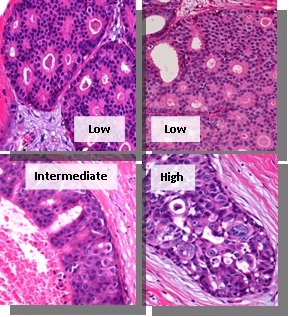In a study published in JAMA Surgery on June 3, researchers from Brigham and Women’s Hospital (BWH) report that breast surgery performed at or shortly after a diagnosis of low-grade ductal carcinoma in-situ (DCIS) did not significantly change patients’ survival rate. The team finds that the survival rate for those with intermediate- and high-grade DCIS does improve with surgery, but the work raises concerns about overtreatment and the necessity and benefit of surgery for all patients with low-grade DCIS.
 |
Figure 1 DCIS is categorized as low-, intermediate- or |
“Until now, the benefit of surgical management for DCIS had not been investigated – we didn’t know the impact of such surgery for this very early breast cancer. By using registry data, we could estimate the benefit,” said corresponding author Yasuaki Sangara, MD, of the BWH Department of Surgery and Dana Farber/Brigham and Women's Cancer Center. “Among patients with high- and intermediate-grade DCIS, we do see a statistical difference between the surgery and non-surgery groups, but that significant benefit was not observed for patients with low-grade DCIS.”
DCIS is a cancer of the milk ducts and is the most common type of non-invasive breast cancer. Improvements in early detection have dramatically increased the number of cases of DCIS and approximately 60,000 women are diagnosed with DCIS each year, which accounts for 20 to 25 percent of new breast cancer cases in the United States.
It is estimated that between 25 percent and 50 percent of DCIS cases may progress to invasive ductal carcinoma. This rate varies depending on whether a woman’s DCIS is categorized as low-, intermediate- or high-grade, but the standard of care for all grades of DCIS is surgery.
“We are over treating breast cancer in the United States and this study, along with others, suggests the need for treatment strategies tailored to a woman’s specific cancer, not just breast cancer in general,” said senior author Mehra Golshan, MD, director of Breast Surgical Services at Dana-Farber/Brigham and Women’s Cancer Center. Golshan is also director of Breast Surgical Services at the Susan F. Smith Center for Women’s Cancers at Dana-Farber Cancer Institute.
The team looked at data from more than 50,000 cases of DCIS available from the SEER (Surveillance, Epidemiology and End Results) database collected between 1998 and 2011 at the Dana-Farber/Brigham and Women’s Cancer Center. For low-grade DCIS, the ten year survival rate for women who did not receive surgery at or shortly after diagnosis was 98.8 percent, and the survival rate for women who did receive surgery was 98.6 percent. For women with intermediate- or high-grade DCIS, the survival rate was significantly different between those who had surgery and those who did not.
“This study alone does not allow us to definitively conclude that breast surgery should be avoided for women with low-grade DCIS, but we believe that a prospective clinical trial – following patients over time from diagnosis through treatment and beyond – is warranted,” said Sagara.